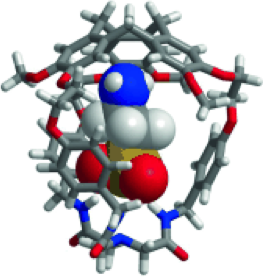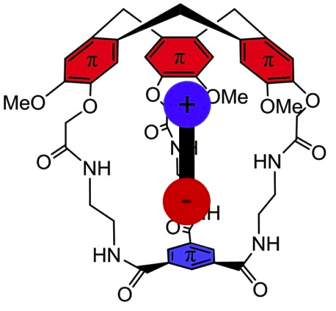Reconnaissance à l'aide d'Hemicryptophanes
Nous étudions ici les propriétés de reconnaissance des hémicryptophanes. En fonction de la taille, de la forme et des fonctions présentent au sein de la cavité, ces structures cages peuvent complexer les paires d’ions, les zwitterions, les ammoniums ou encore les carbohydrates.

Cooperativity favors anion recognition in heteroditopic hemicryptophane complexes

Hemicryptophane selectively binds
taurine neurotransmitter in water

Brothers enemies anion-π and cation-π interactions act in a synergistic way when gathered in the molecular cavity of a hemicryptophane host to afford –170 kJ/mol efficient contributions in zwitterions recognition.
Personnes impliquées : Oliver Perraud, Aline Schmitt, Alexandre Martinez, Jean-Pierre Dutasta
Publications relatives :
1. “Gathering Cation-π and Anion-π Interactions for Zwitterions Recognition” O. Perraud, V. Robert, H. Gornitzka, A. Martinez, J. P. Dutasta Angew. Chem. Int. Ed. 2012, 51, 504-508.
2. “Hemicryptophane host as efficient primary alkylammonium ion receptor” O. Perraud, V. Robert, H. Gornitzka, A. Martinez, J. P. Dutasta Org. Bio. Chem. 2011, in press.
3” A Designed Cavity for Zwitterionic Species: Selective Recognition of Taurine in Aqueous Media” O. Perraud, V. Robert, A. Martinez, and J.-P. Dutasta Chem. Eur. J. 2011, in press, DOI: 10.1002/chem.201101522
5. “The Cooperative Effect in Ion-Pair Recognition by a Ditopic Hemicryptophane Host“ O. Perraud, V. Robert, A. Martinez, and J.-P. Dutasta, Chem. Eur. J. 2011, 17, 4177.
6. “Exclusive enantioselective recognition of glucopyranosides by inherently chiral hemicryptophanes” O. Perraud, A. Martinez, and J.-P. Dutasta, Chem. Comm., 2011, 47, 5861.



